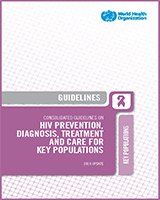3.1. Services for all key populations
A combination of interventions is required to respond effectively to HIV among key populations. The following comprehensive package of interventions is recommended to assist countries with programming for HIV prevention and treatment among key populations. While Chapters 4 and 5 describe the interventions in much more detail, here we summarize the overarching headings.
The package has two parts
Essential health sector interventions (see
Chapter 4 for detail)
comprehensive condom and lubricant programming
harm reduction interventions for substance use, in particular needle and syringe programmes
1 and opioid substitution therapy
behavioural interventions
HIV testing and counselling
HIV treatment and care
prevention and management of co-infections and other co-morbidities, including viral hepatitis, TB and mental health conditions
sexual and reproductive health interventions.
2
Essential strategies for an enabling environment (see
Chapter 5 for detail)
supportive legislation, policy and financial commitment, including decriminalization of behaviours of key populations
addressing stigma and discrimination
community empowerment
addressing violence against people from key populations.
- 1
Needle and syringe programmes are important for people who inject drugs and also for transgender people who require sterile injecting equipment to safely inject hormones for gender affirmation. Other important areas include for tattooing, piercing and other forms of skin penetration, which are particularly relevant in prisons and other closed settings.
- 2
Including contraception, diagnosis and treatment of STIs, cervical screening, etc. (see Chapter 4).
The interventions and strategies included in this package are significantly interdependent.
The interventions and strategies in this package are significantly interdependent. The health sector interventions yield the most benefit when they are available in combination and when the necessary enabling environmental factors are in place. These health sector interventions should not be delayed because the enabling environmental factors are missing. The presence of the enabling factors will greatly increase their impact, however. Thus, while the enabling factors may be largely outside the control of the health sector, it is important for the health sector to address them jointly with other sectors.
In addition to the interventions listed, people from key populations need access to general medical, social welfare and legal services so that they can attain the highest possible standards of health and well-being.
3.2. Specific considerations
The comprehensive package outlined above is relevant for all people in key populations. Additional elements for specific key populations are summarized below and detailed in Chapters 4 and 5.
3.2.1. Prisons and other closed settings
The services for prevention and treatment of HIV in the community should also be provided to people in prison and other closed settings. The proven efficacy of these interventions in the community will not change when they are delivered in prisons and other closed settings. However, there may be some specific considerations as to how best to deliver these services in prisons and other closed settings to maximize their effectiveness. To improve the equity of health care in these settings, consideration should be given to assigning responsibility for prison health to the ministry of health rather than the ministry of justice or interior (3).
In 2013 UNODC and partners agreed on a comprehensive package for effective HIV prevention and treatment in prisons and other closed settings. In addition to the recommended interventions for people in the community, interventions relevant to closed settings include:
prevention of HIV transmission through medical and dental services
prevention of transmission of HIV and other bloodborne diseases through tattooing, piercing and other forms of skin penetration
protecting staff from occupational hazards.
Some other interventions are important and should not be overlooked, such as the distribution of toothbrushes and shavers in basic hygiene kits, adequate nutrition, intimate visit programmes, palliative care and compassionate release for terminal cases (4).
3.2.2. People who inject drugs
This package is essentially the same as the comprehensive package for HIV prevention, treatment and care for people who inject drugs that has been widely endorsed at the highest political level and by major donor agencies (1, 2). While the harm reduction interventions for substance use are part of this overall comprehensive package for key populations, it is important that countries where injecting drug use occurs prioritize immediate implementation of needle and syringe programmes and opioid substitution therapy (NSPs and OST). Implementation of these essential harm reduction services should facilitate and enhance access to HIV-specific services, such as HIV testing and counselling and antiretroviral therapy, and improve adherence to treatment. Harm reduction interventions for people who use drugs but who do not inject are also important. They should include evidence-based drug dependence treatment and provision of non-injecting drug use paraphernalia as appropriate to the local context and patterns of drug use.
3.2.3. Adolescents from key populations
The comprehensive package of interventions is also relevant for adolescents from key populations. Programming for adolescents should also include:
Countries are encouraged to:
Critical knowledge gaps remain, however, concerning how best to implement programmes that address adolescents' needs (5). However, it is essential that services are designed and delivered in a way that takes into account the multiple, overlapping vulnerabilities that confront adolescents from key populations, and their different needs based on their age, specific behaviours, the complexities of their social and legal environment and the epidemic setting.

